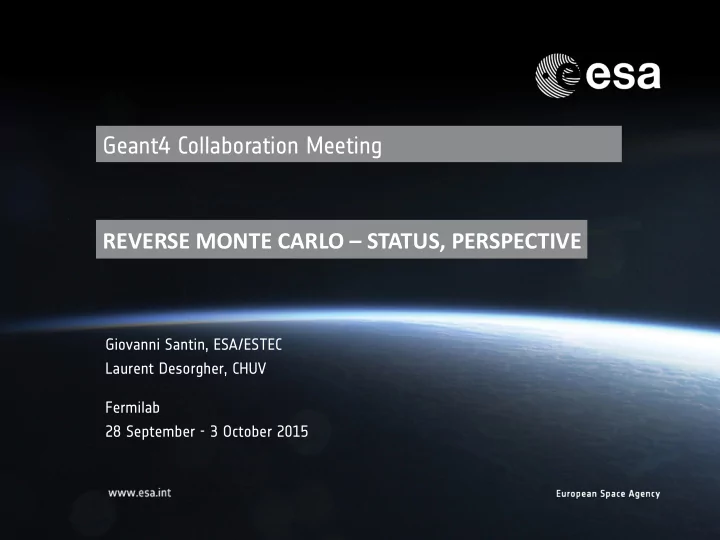

Geant4 Collaboration Meeting → REVERSE MONTE CARLO – STATUS, PERSPECTIVE Giovanni Santin, ESA/ESTEC Laurent Desorgher, CHUV Fermilab 28 September - 3 October 2015
Overview • Recap of Reverse / Adjoint Monte Carlo in Geant4 • Slides and plots from Laurent’s last year contribution in Okinawa • Perspectives 2 Giovanni Santin - Geant4 Collaboration Workshop 2015
Variance Reduction Techniques Reverse / Adjoint Monte Carlo • Addresses two main sources of inefficiency in simulations of space systems – shielding effectiveness and • Adjoint Monte Carlo: physics based – low geometrical cross section importance biasing, based on reverse tracking 3 Giovanni Santin - Geant4 Collaboration Workshop 2015
Reverse Monte Carlo transport • Real MC simulation (not back-extrapolation of tracks) • New transport eq., “adjoint” to the “forward” eq. • During reverse transport 1. Simulation starts at new “adjoint source” close to target and scores at external source • Successive points are higher in energy, earlier in time 2. Check at external source, the adjoint particle must belong to the real source phase-space, otherwise it is rejected 3. Each adjoint physics process modifies particle weight 4. Final weight at external source determines probability of existence for tracked particle 5. This weight is used as source biasing for a forward/direct simulations, from the adjoint source towards the target 4 Giovanni Santin - Geant4 Collaboration Workshop 2015
Reverse MC tools • First adjoint Monte Carlo transport algorithms developed in the 1960’s • Until very recently only implementation by Jordan (1976) in NOVICE was available to space community. It soon became an indispensable tool, a de facto standard particularly in the industrial context. • Implementations of some adjoint MC transport capabilities available in MCNP, AMC, ITS 5.0 • More recently, reverse MC capabilities became available in GEANT4 (e-, 𝜹 , protons, ions) and FASTRAD (e - , 𝜹 ) - two separate development lines funded by ESA and CNES T M Jordan, IEEE Trans Nucl Sci., 23, p1857, 1976 P . Pourrouquet et al., NSREC 2011 Conference Proceedings L. Desorgher, F. Lei, G Santin, Nucl Instr Meth A, 2010 5 Giovanni Santin - Geant4 Collaboration Workshop 2015
Reverse Monte Carlo in Geant4 • Base adjoint classes and reverse processes distributed in the G4 toolkit (ESA funded) • Documentation in the Geant4 user guide for application developer – Geant4 example extended/biasing/ReverseMC1 – Publication in NIMA: – L. Desorgher, F. Lei, G Santin, NIM A, 2010 • Implemented reverse processes: – Ionisation (continuous and discrete) for e-, proton and ion – Multiple scattering – Bremsstrahlung – Compton scattering – Photo-electric effect 6 Giovanni Santin - Geant4 Collaboration Workshop 2015
Geant4 exam ple extended/ biasing/ ReverseMC1 Spherical Al shielding radius 10 cm user defined thickness Tantalum plates 0.5mm thick Energy deposited in small Si sensitive cylinder with variable size External spherical source radius 10 cm primary particles e- , and proton • Comparisons forward and reverse computations • Illustrates changes needed in a G4 application to use the Reverse MC mode • Shows new G4 macro commands relative to adjoint simulation 7 Giovanni Santin - Geant4 Collaboration Workshop 2015
Reverse Monte Carlo in GRAS • GRAS upgraded (version 3.0+) to use the Geant4 Reverse MC toolkit classes • Automatic normalisation to user-defined primary spectra (e.g. exp -E/E0 , E - α , arb.) – Computation of response matrix/yield function • Recording convergence of simulation results – Automatic stop when user-defined precision is reached 8 Giovanni Santin - Geant4 Collaboration Workshop 2015
Convergence issues • End point: Total Ionising Dose in target volume (== RMC source volume) • Jumps in total dose and RMS, slowing down convergence • Looking for culprit: dose from some rare gamma interactions / high reverse weight? – Attempt to limit impact with splitting 9 Giovanni Santin - Geant4 Collaboration Workshop 2015
Convergence of results • For thin shielding convergence is fast and gamma spectra look reasonably correct (w.r.t Geant4 Forward MC) • Thick shielding still show some significant peaks and slow convergence 10 Giovanni Santin - Geant4 Collaboration Workshop 2015
Dose in Si after Alum inium shielding Jupiter m ission • Convergence is much faster without reverse Photo-Electric and reverse Compton • But these processes appear as important for final dose end-points 11 Giovanni Santin - Geant4 Collaboration Workshop 2015
Perspective • Laurent still working with Geant4 and interested in continuing RMC development, although now in new environment at CHUV Lausanne • From ESA strong interest in understanding and fixing remaining issues – Reliable Reverse MC would be of interest for industry and research institutes for all missions, from Science to Earth Observation to Telecomm • Final observables come from combined effect of code in Geant4 and application (GRAS in this case) – Systematic testing and fresh look at code being organised – Design changes required to move to MT – Very specific expertise in RMC and biasing is required, nevertheless ideas and practical help appreciated 12 Giovanni Santin - Geant4 Collaboration Workshop 2015
Thank you 13 Giovanni Santin - Geant4 Collaboration Workshop 2015
Recommend
More recommend